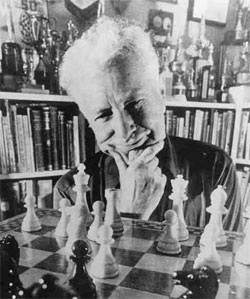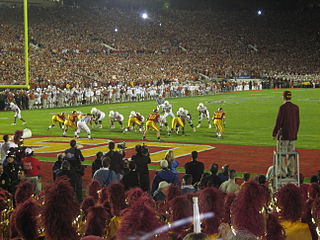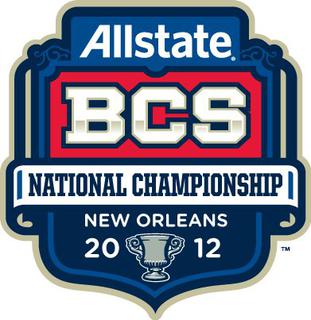
The Elo rating system is a method for calculating the relative skill levels of players in zero-sum games such as chess. It is named after its creator Arpad Elo, a Hungarian-American physics professor.
A tournament is a competition involving at least three competitors, all participating in a sport or game. More specifically, the term may be used in either of two overlapping senses:
- One or more competitions held at a single venue and concentrated into a relatively short time interval.
- A competition involving a number of matches, each involving a subset of the competitors, with the overall tournament winner determined based on the combined results of these individual matches. These are common in those sports and games where each match must involve a small number of competitors: often precisely two, as in most team sports, racket sports and combat sports, many card games and board games, and many forms of competitive debating. Such tournaments allow large numbers to compete against each other in spite of the restriction on numbers in a single match.

The Peach Bowl is an annual college football bowl game played in Atlanta, Georgia, since December 1968. Since 1997, it has been sponsored by Chick-fil-A and is officially known as the Chick-fil-A Peach Bowl. From 2006 to 2013, it was officially referred to as simply the Chick-fil-A Bowl. The winner of the bowl game is awarded the George P. Crumbley Trophy, named after the game's founder George Crumbley.

The Bowl Championship Series (BCS) was a selection system that created four or five bowl game match-ups involving eight or ten of the top ranked teams in the NCAA Division I Football Bowl Subdivision (FBS) of American college football, including an opportunity for the top two teams to compete in the BCS National Championship Game. The system was in place for the 1998 through 2013 seasons and in 2014 was replaced by the College Football Playoff.

In North America, a bowl game, or simply bowl, is one of a number of postseason college football games that are primarily played by teams belonging to the NCAA's Division I Football Bowl Subdivision (FBS). For most of its history, the Division I Bowl Subdivision had avoided using a playoff tournament to determine an annual national champion, which was instead traditionally determined by a vote of sports writers and other non-players. In place of such a playoff, various cities across the United States developed their own regional festivals featuring postseason college football games. Prior to 2002, bowl game statistics were not included in players' career totals. Despite attempts to establish a permanent system to determine the FBS national champion on the field, various bowl games continue to be held because of the vested economic interests entrenched in them.
A sports league is a group of individual athletes, sports teams or clubs who form a league to compete against each other and gain points in a specific sport. At its simplest, it may be a local group of amateur athletes who form teams among themselves and compete periodically, at its most complex, it can be an international professional league making large amounts of money and involving dozens of teams and thousands of players.
Jeff Sagarin is an American sports statistician known for his development of a method for ranking and rating sports teams in a variety of sports. His Sagarin Ratings have been a regular feature in the USA Today sports section from 1985 to 2023, have been used by the NCAA Tournament Selection Committee to help determine the participants in the NCAA Men's Division I Basketball Championship tournament since 1984, and were part of the college football Bowl Championship Series throughout its history from 1998 to 2014.

Kenneth Massey is an American sports statistician known for his development of a methodology for ranking and rating sports teams in a variety of sports. His ratings have been a part of the Bowl Championship Series since the 1999 season. He is an assistant professor of mathematics at Carson–Newman University in Tennessee.
In a group tournament, unlike a knockout tournament, there is no scheduled decisive final match. Instead, all the competitors are ranked by examining the results of all the matches played in the tournament. Typically, points are awarded for each match, with competitors ranked based either on total number of points or average points per match.
In American college football, the 2006 BCS computer rankings are a part of the Bowl Championship Series (BCS) formula that determines who plays in the BCS National Championship Game as well as several other bowl games. Each computer system was developed using different methods which attempts to rank the teams' performance. For 2006, the highest and lowest rankings for a team are dropped and the remaining four rankings are summed. A team ranked #1 by a computer system is given 25 points, #2 is given 24 points and so forth. The summed values are then divided by 100. The values are then ranked by percentage. This percentage ranking is then averaged with the Coaches Poll and Harris Poll average rankings, each receiving equal weight, and the results become the BCS Rankings.
In American college football, the 2007 BCS computer rankings are a part of the Bowl Championship Series (BCS) formula that determines who plays in the BCS National Championship Game as well as several other bowl games. Each computer system was developed using different methods which attempts to rank the teams' performance. For 2007, the highest and lowest rankings for a team are dropped and the remaining four rankings are summed. A team ranked #1 by a computer system is given 25 points, #2 is given 24 points and so forth. The summed values are then divided by 100. The values are then ranked by percentage. This percentage ranking is then averaged with the Coaches Poll and Harris Poll average rankings, each receiving equal weight, and the results become the BCS Rankings.
The Bowl Championship Series (BCS) was a selection system used between 1998 and 2013 that was designed, through polls and computer statistics, to determine a No. 1 and No. 2 ranked team in the NCAA Division I Football Bowl Subdivision (FBS). After the final polls, the two top teams were chosen to play in the BCS National Championship Game which determined the BCS national champion team, but not the champion team for independent voting systems. This format was intended to be "bowl-centered" rather than a traditional playoff system, since numerous FBS Conferences had expressed their unwillingness to participate in a play-off system. However, due to the unique and often esoteric nature of the BCS format, there had been controversy as to which two teams should play for the national championship and which teams should play in the four other BCS bowl games. In this selection process, the BCS was often criticized for conference favoritism, its inequality of access for teams in non-Automatic Qualifying (non-AQ) Conferences, and perceived monopolistic, "profit-centered" motives. In terms of this last concern, Congress explored the possibility on more than one occasion of holding hearings to determine the legality of the BCS under the terms of the Sherman Anti-Trust Act, and the United States Justice Department also periodically announced interest in investigating the BCS for similar reasons.
In sports, strength of schedule (SOS) refers to the difficulty or ease of a team's/person's opponent as compared to other teams/persons. This is especially important if teams in a league do not play each other the same number of times.

The Fordham Rams football program is the intercollegiate American football team for Fordham University, located in the borough of The Bronx in New York City. The team competes in the NCAA Division I Football Championship Subdivision (FCS) and are members of the Patriot League. Fordham's first football team was fielded 142 years ago in 1882; the team plays its home games on campus at 7,000-seat Coffey Field.

The 2012 Allstate BCS National Championship Game was a postseason college football bowl game between the Alabama Crimson Tide and the LSU Tigers, and determined the national champion of the 2011 NCAA Division I FBS football season on Monday, January 9, 2012, at the Mercedes-Benz Superdome in New Orleans, Louisiana. The game was part of the 2011–2012 Bowl Championship Series and a rematch of regular season foes. Alabama beat LSU 21–0 to win their 14th national championship, marking the first shutout in a national championship game since the 1992 Orange Bowl and the first ever shutout in a BCS bowl game. The game had the third-lowest TV rating, 14.01, in the 14-year history of the BCS National Championship game.
The 2008 Texas vs. Texas Tech football game was a Big 12 Conference college football game played between the Texas Longhorns and Texas Tech Red Raiders at Jones AT&T Stadium in Lubbock, Texas. The game was played on November 1 and was one of the most memorable games in the two teams' rivalry. Heading into the game, both teams were undefeated at 8–0. Texas entered game as the top-ranked team in the nation, led by coach Mack Brown. The Red Raiders, headed by coach Mike Leach, were ranked sixth. The Red Raiders stunned the Longhorns 39–33 on a last-second touchdown pass. The game appeared over on the previous play, but Texas dropped a potential interception. The game is one of the greatest upsets in the rivalry's history and was crucial in producing a three-way tie in the Big 12 at the end of the season.
The plus-one system, also known as a 4-team playoff, is the system used to determine the National Champion in the Football Bowl Subdivision of NCAA football in the United States. The format is of a 4-team playoff, where two bowl games act as semi-final games, and the winners of these games participate in the National Championship Game.

The College Football Playoff (CFP) is an annual postseason knockout invitational tournament to determine a national champion for the National Collegiate Athletic Association (NCAA) Division I Football Bowl Subdivision (FBS), the highest level of college football competition in the United States. It culminates in the College Football Playoff National Championship game. The inaugural tournament was held at the end of the 2014 NCAA Division I FBS football season under a four-team format. The CFP expands to include twelve teams for the 2024 season.

The Mountain West Conference Football Championship Game is an annual postseason college football game played to determine the champion of the Mountain West Conference (MW).
The Colley Matrix is a computer-generated sports rating system designed by Dr. Wesley Colley. It is one of more than 40 polls, rankings, and formulas recognized by the NCAA in its list of national champion selectors in college football.











